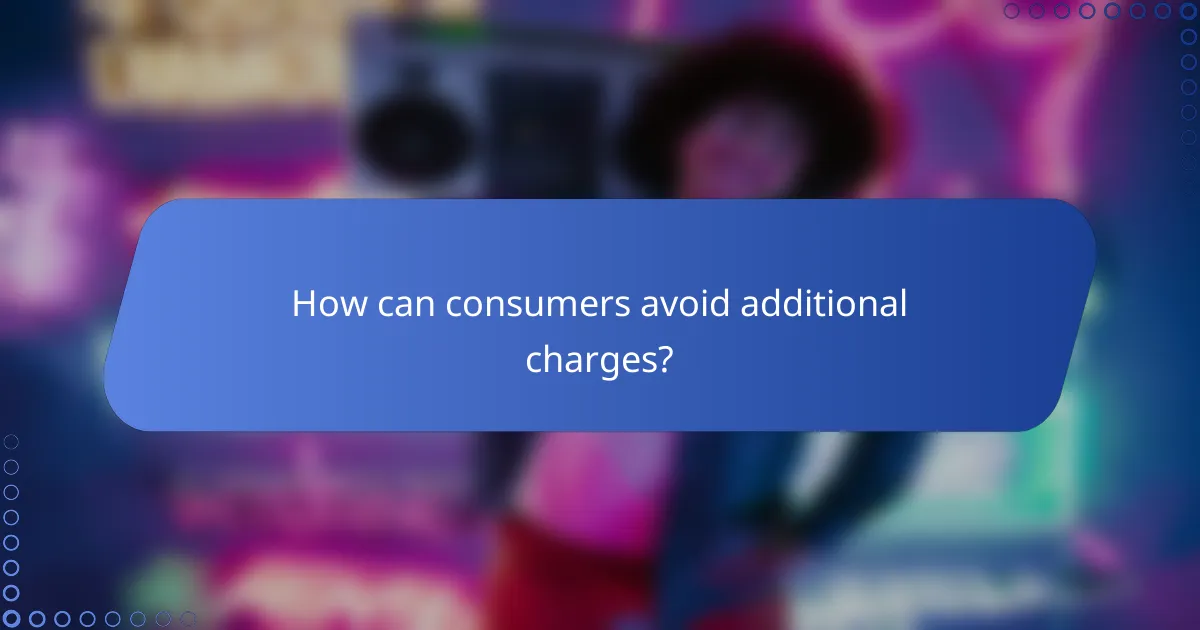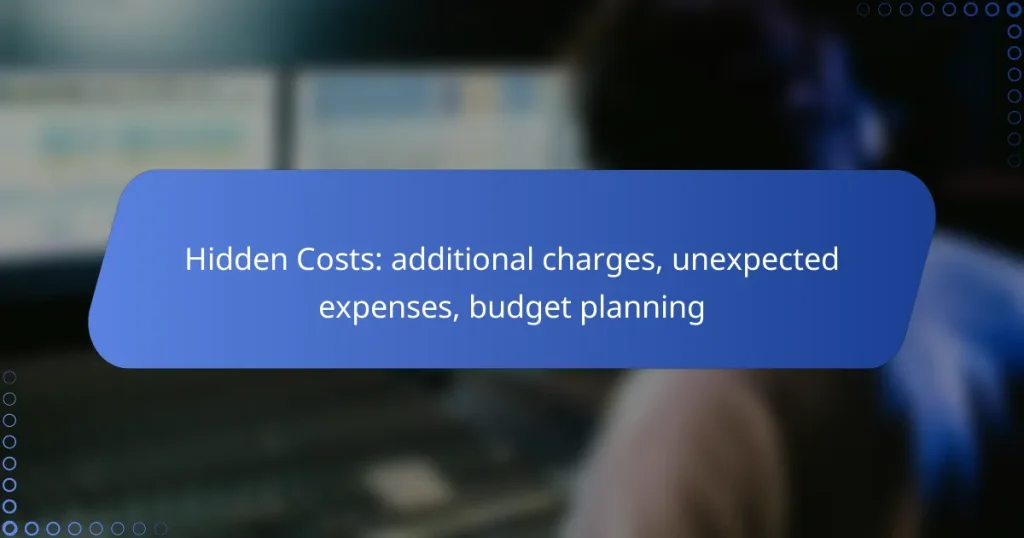Hidden costs can significantly impact your financial planning, often surfacing as additional charges that inflate the total price of a purchase. Recognizing these unexpected expenses is essential for effective budget management, allowing individuals and businesses to prepare for financial surprises. By employing strategic budget planning, you can create a more resilient financial framework that accommodates both anticipated and unforeseen costs.

What are the hidden costs in e-commerce?
Hidden costs in e-commerce refer to additional charges that can unexpectedly inflate the total price of a purchase. These costs often go unnoticed until checkout or after a transaction is completed, making budget planning crucial for both consumers and businesses.
Shipping fees
Shipping fees are one of the most common hidden costs in e-commerce. These charges can vary widely based on the shipping method, distance, and carrier. It’s essential to compare shipping options and consider free shipping thresholds offered by many retailers to minimize these costs.
For instance, standard shipping might cost around $5 to $10, while expedited options can range from $15 to $30 or more. Always check if the retailer offers flat-rate shipping or free shipping for orders above a certain amount.
Import duties
Import duties are taxes imposed by a government on goods brought into the country. These charges can significantly increase the total cost of international purchases and vary by product type and destination country. Understanding the applicable tariffs can help in budgeting for these expenses.
For example, import duties in the European Union can range from 0% to over 20%, depending on the item. It’s advisable to research the specific duties for your purchase to avoid surprises at customs.
Return shipping costs
Return shipping costs can catch consumers off guard, especially if they need to send back an item. Many retailers do not cover these expenses, leaving the buyer responsible for the return shipping fee. This can add an unexpected amount to the overall cost of a purchase.
Consider retailers with free return shipping policies, which can save money and hassle. If return shipping is not covered, check the estimated costs beforehand, which can range from $5 to $15 depending on the carrier and distance.
Payment processing fees
Payment processing fees are charges incurred when a transaction is completed through a payment gateway. These fees can be a percentage of the sale or a flat rate, and they may not be disclosed until after the purchase is made. Businesses should factor these fees into their pricing strategy to maintain profitability.
Typically, payment processing fees can range from 1.5% to 3% of the transaction amount. For larger purchases, this can add up quickly, so it’s wise to choose payment methods that minimize these costs.
Packaging charges
Packaging charges refer to costs associated with the materials used to package products for shipment. Some retailers may include these fees in the overall price, while others may list them separately. Understanding these charges can help consumers make informed decisions about their purchases.
Packaging costs can vary, but they often range from $1 to $5 per order, depending on the type of packaging used. When shopping, look for retailers that offer eco-friendly packaging options, which may also reduce costs in some cases.

How to identify unexpected expenses?
Identifying unexpected expenses involves closely monitoring your financial activities and recognizing patterns that lead to additional charges. By being proactive and vigilant, you can better manage your budget and avoid surprises.
Reviewing invoices
Regularly reviewing invoices is crucial for spotting unexpected expenses. Check each line item for accuracy and ensure that you are only being charged for services or products you agreed to. Look for recurring charges that might have gone unnoticed, such as subscription fees or maintenance costs.
Consider setting a reminder to review invoices monthly. This practice can help you catch discrepancies early and address them with service providers promptly.
Tracking spending habits
Tracking your spending habits allows you to see where your money goes and identify areas where unexpected expenses may arise. Use a simple method, like a spreadsheet or a mobile app, to categorize your expenses into fixed and variable costs.
Pay attention to categories that often lead to overspending, such as dining out or entertainment. Aim to limit discretionary spending to a reasonable percentage of your overall budget to mitigate surprise costs.
Using budgeting tools
Utilizing budgeting tools can significantly enhance your ability to identify unexpected expenses. Many apps and software options allow you to set budgets for different categories and track your spending in real-time.
Look for tools that provide alerts when you exceed your budget or when unusual spending patterns are detected. This proactive approach can help you stay on top of your finances and avoid unexpected financial burdens.

What are effective budget planning strategies?
Effective budget planning strategies help individuals manage their finances by anticipating expenses and setting aside funds for unexpected costs. By implementing these strategies, you can create a more resilient budget that accommodates both planned and unforeseen financial demands.
Setting a contingency fund
A contingency fund is a financial safety net that covers unexpected expenses, such as medical emergencies or urgent repairs. Aim to save at least three to six months’ worth of living expenses in this fund to ensure you have enough to handle unforeseen situations without derailing your budget.
To build your contingency fund, start by setting aside a small percentage of your monthly income. Consider automating transfers to this fund to make saving easier and more consistent.
Prioritizing essential purchases
Prioritizing essential purchases involves distinguishing between needs and wants to allocate your budget effectively. Focus on necessities like housing, utilities, food, and healthcare before considering discretionary spending.
To streamline this process, create a list of your monthly expenses and categorize them into essential and non-essential items. This will help you identify areas where you can cut back if needed, ensuring that your budget remains balanced.
Utilizing budgeting apps
Budgeting apps can simplify financial management by providing tools to track spending, set goals, and analyze your budget in real-time. Many popular apps offer features like expense categorization and alerts for overspending, making it easier to stay on track.
When choosing a budgeting app, look for one that fits your lifestyle and offers features that align with your financial goals. Some apps are free, while others may charge a subscription fee, so consider your budget when selecting the right tool for you.

How can consumers avoid additional charges?
Consumers can avoid additional charges by being proactive in their research and understanding the costs associated with purchases. By carefully examining terms, comparing prices, and checking for hidden fees, individuals can better manage their budgets and minimize unexpected expenses.
Reading terms and conditions
Reading terms and conditions is crucial to understanding the full scope of any agreement. These documents often contain important information about fees, penalties, and obligations that may not be immediately apparent. For instance, a subscription service might have a low introductory price but include automatic renewal clauses that could lead to higher charges later.
To effectively navigate these documents, look for sections that outline payment terms, cancellation policies, and any potential extra charges. Highlighting or noting key points can help you remember critical details that affect your budget.
Comparing prices across platforms
Comparing prices across different platforms can reveal significant variations in costs, including hidden charges. For example, one travel booking site may offer a lower fare but add service fees at checkout, while another may include those fees in the displayed price. Always check multiple sources to ensure you’re getting the best deal.
Utilizing price comparison websites can streamline this process. These tools allow you to see various options side by side, making it easier to identify the most cost-effective choice while considering all associated fees.
Checking for hidden fees
Checking for hidden fees is essential to avoid surprises during transactions. Common hidden fees include service charges, processing fees, and taxes that may not be included in the initial price quote. For instance, when renting a car, additional costs for insurance or fuel can significantly increase the total expense.
To uncover these fees, read reviews and ask questions before finalizing a purchase. Look for customer feedback that mentions unexpected costs and ensure you clarify any uncertainties with the seller or service provider. This diligence can save you money and help you stick to your budget.

What are the implications of unexpected expenses in Canada?
Unexpected expenses in Canada can significantly impact personal finances, often leading to budget overruns and financial stress. These costs may arise from various sources, including medical emergencies, car repairs, or home maintenance, making it essential to plan for them effectively.
Common sources of unexpected expenses
Unexpected expenses can stem from numerous situations. Common sources include medical bills, vehicle repairs, home maintenance issues, and sudden travel needs. For instance, a minor car accident may result in repair costs that can range from a few hundred to several thousand Canadian dollars.
Additionally, unexpected medical expenses can arise, especially if you are not fully covered by provincial health insurance. This could mean out-of-pocket costs for prescriptions or specialist visits that can quickly add up.
How to prepare for unexpected expenses
Preparing for unexpected expenses involves creating a financial buffer. A good rule of thumb is to aim for an emergency fund that covers three to six months of living expenses. This fund can help you manage unforeseen costs without derailing your budget.
Consider setting aside a specific percentage of your monthly income into this fund. Even small contributions can accumulate over time, providing a safety net when unexpected expenses arise.
Strategies to manage unexpected expenses
To effectively manage unexpected expenses, prioritize your spending and identify areas where you can cut back. For example, if you know that car repairs are a possibility, consider reducing discretionary spending on entertainment or dining out.
Another strategy is to regularly review your budget and adjust it as needed. This allows you to allocate funds for potential emergencies while still covering your essential expenses. Using budgeting apps can help track your spending and ensure you stay on target.


